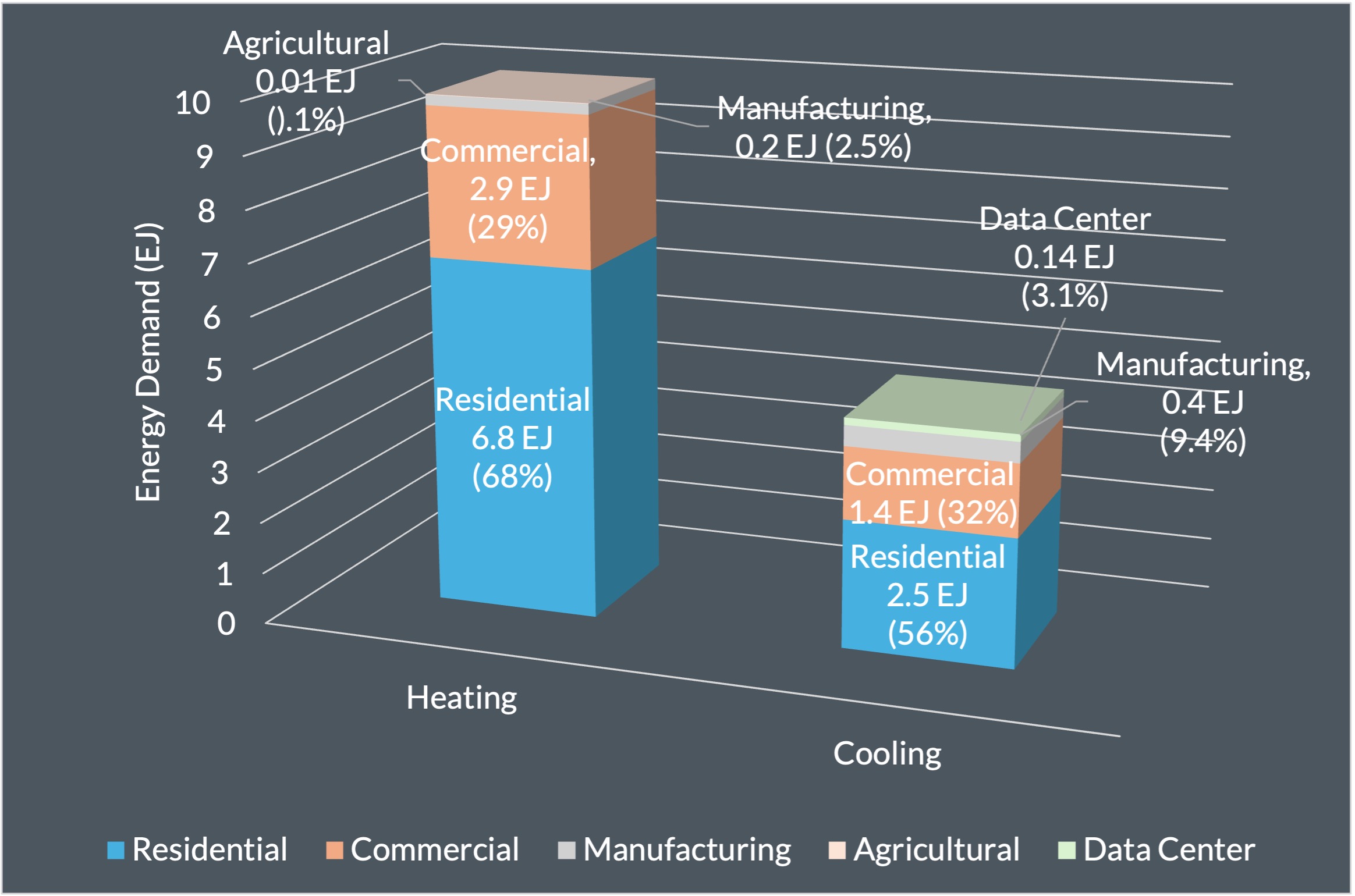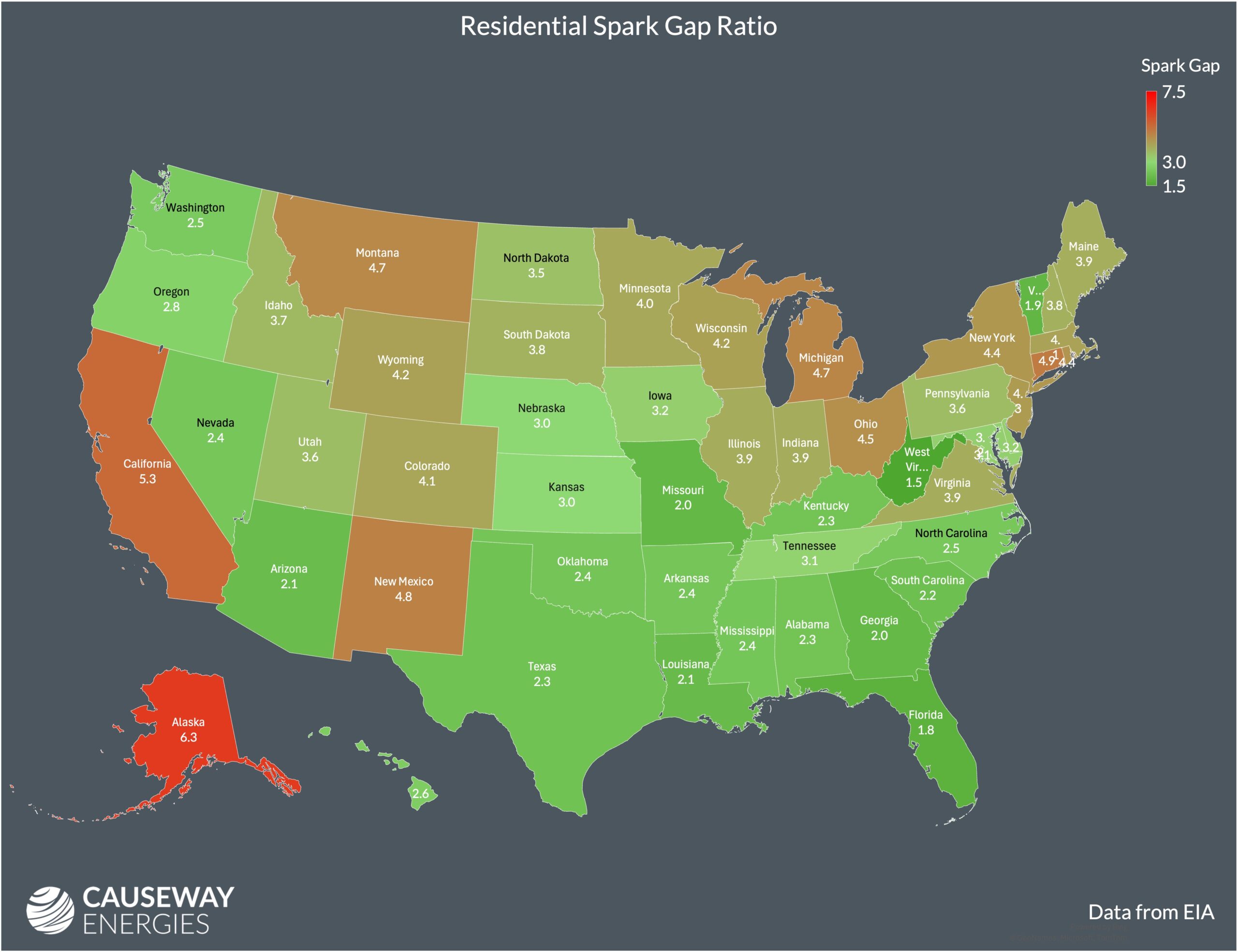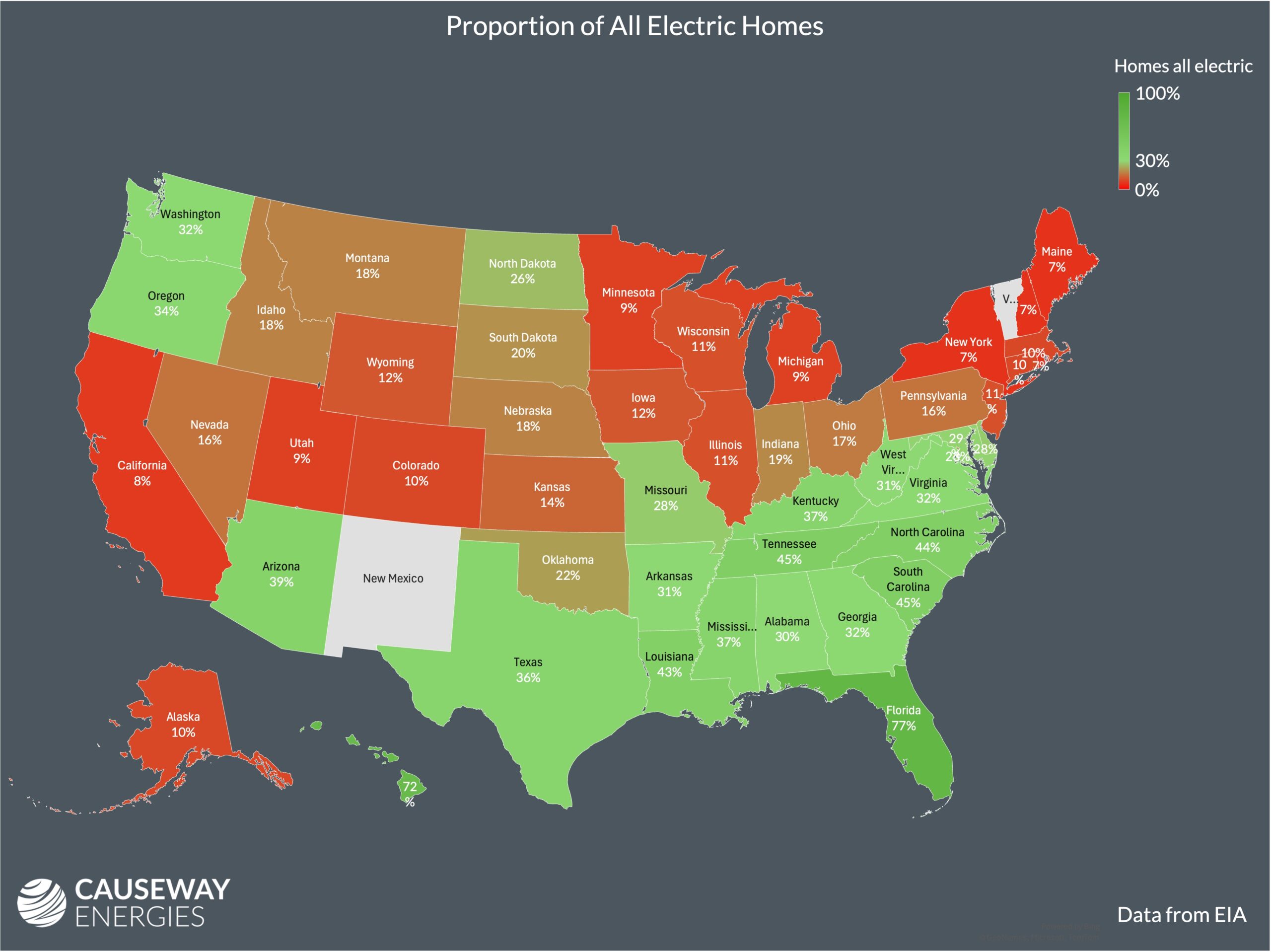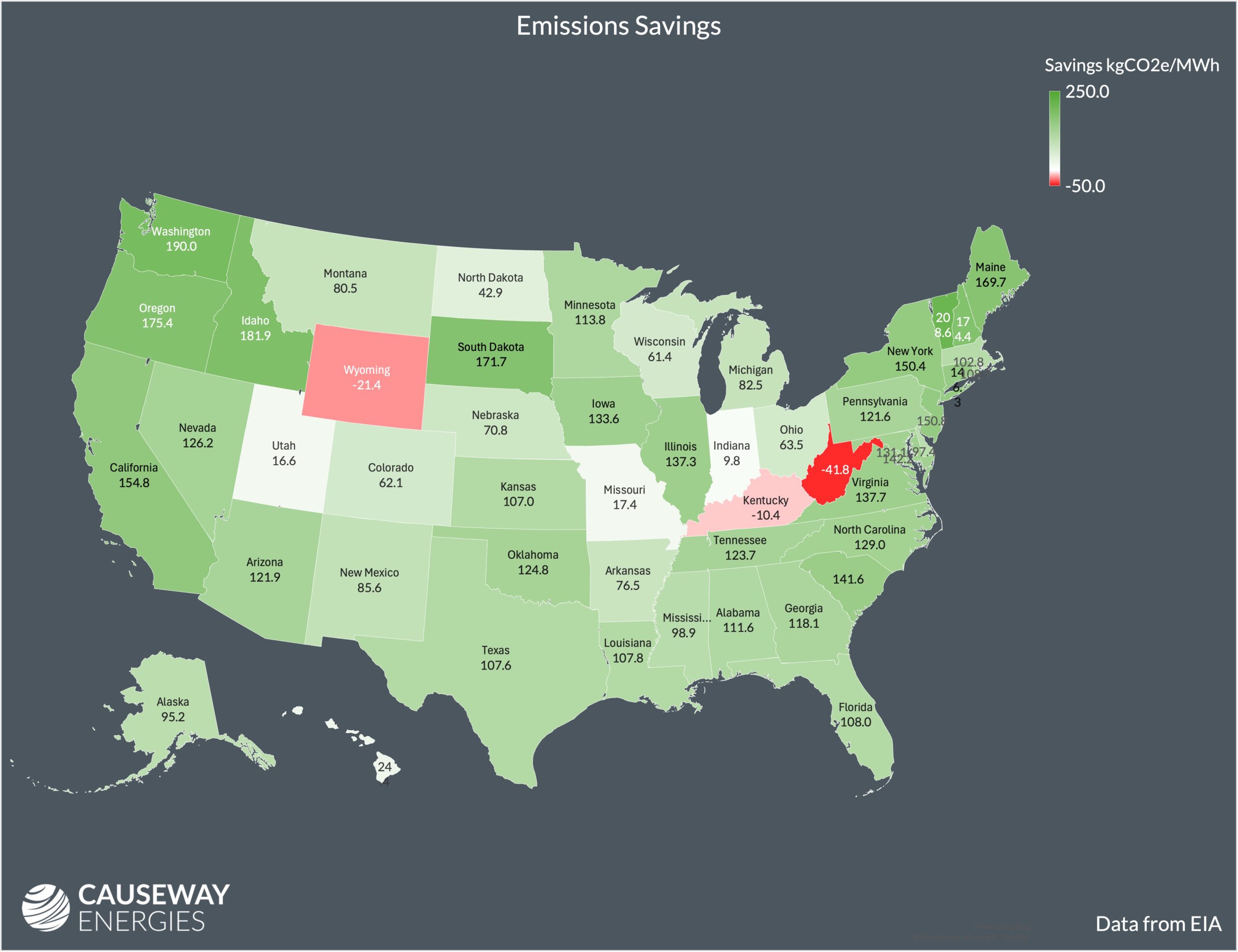Where and why do geothermal heat pumps make most economic sense in the United States?
Posted on Tuesday, October 1st, 2024
Posted on Tuesday, October 1st, 2024

Figure 1: U.S. low-temperature heating (< 150 ºC (300 ºF)) and cooling demand in the end-use sectors/categories from Oh & Beckers 2023.
Causeway Energies has learnt a lot about the economics and climate impact of heat pumps, especially big ones, in the last 4 years. We’ve learnt from both theory and particularly practice in our engagements with Commercial & Industrial (C&I) clients.
While we founded Causeway in Ireland and the UK, we have always had an eye on the US market, given the huge demand for low/zero carbon heat in this country (Figure 1). Furthermore, typically of our other target geographies, the majority of this heat is lower temperature, less than 150 ºC (300 ºF), putting it well within the reach of industrial heat pumps. We now feel that it’s time to start engaging with clients in the US and seeking to build some projects with our proprietary knowhow and geothermal technologies.
But where to start?
Although the Inflation Reduction Act and other measures by the current administration is increasing the drive for decarbonization, it’s still a matter of economics that is the first thing to consider in ranking areas to deploy heat pumps.
Spark Gaps and COPs
To understand the decarbonisation economics, we need to understand the fundamentals of how electric heat pumps compete on a cost basis with fossil fuels. Heat pumps, particularly those that use geothermal energy from boreholes as the natural, clean energy source, are typically more expensive (higher capex) than gas boilers. To make up for that difference, the running costs of the Geothermal Heat Pump (GHP) have to be significantly lower than those for the gas boiler. The difference in running costs between the two systems are about two things:
Unit electricity costs (¢/KWh) are typically 2 or more times the unit costs of natural gas. This difference is now typically referred to as the “spark gap” or “spark spread” and is a region or facility’s electricity unit cost divided by the gas unit cost.
So for GHPs to be level with boilers on running costs, the COP of the GHP needs to be similar to the Spark Gap so that greater efficiency of the GHP with respect to purchased energy outweighs the greater expense of electricity relative to natural gas.
In fact, for the additional capex for a GHP to be paid back to the consumer in a reasonable time, say 7 years or less, the COP needs to be significantly higher than the Spark Gap so those operational energy savings are repaying the extra capital. This is crucial for investors in larger-scale industrial projects, as that additional headspace makes for a return on investment in the upfront capital costs.

Figure 2: The Spark Gap for residential power and natural gas in the United States. Data for 1H 2024 from the EIA.

Figure 3: Proportion of All Electric Homes in the United States. (Data from the Residential Energy Consumption Survey (RECS) of EIA).
Residential heat pumps
With heat pump economics math in mind we can now use the regional variations in electricity and natural gas costs, specifically calculating the Spark Gap, to highlight areas where heat pumps might make most sense (Figure 2). Furthermore, we can test the model using residential energy data also from the EIA to compare and contrast Spark Gap with the proportion of electrification (Figure 3).
The correlation is quite striking. The south has the greatest proportion of all electric homes and heat pumps installed for heat, and this correlates very well with very low Spark Gaps.
In the Northeast (New England) the proportion of heat pump applications is low, inversely correlating with Spark Gap which is higher. There are other factors at play here, for example a larger proportion of older buildings that inherit natural gas, fuel oil and other fossil fuel systems. There is also an historical negative perception from poor results to use air source heat pumps in the northern colder climates. Nevertheless, companies like Dandelion Energy have been taking on the displacement of residential fossil fuel systems with GHPs, demonstrating how geothermal or ground source heat pumps do a much better job than air source and further innovating and improving their systems to reduce installation costs and improve COP (up to 5.2 according to Dandelion).
Higher COPs in the heat pump systems of more than 4.0, or even 5.0, dramatically increases the number of US states in which residential heat can be electrified economically. Furthermore, homeowners taking action like “prosumer” solar PV on the roof, green and night time tarrifs, smart metering, and battery storage, can significantly reduce the “blended” cost of their electricity and pushing the economic balance further to the clean energy winner.
The lack of electrification and heat pump deployment in California might come as a surprise when the state’s climate friendliness is considered. However, seeing that the Spark Gap is the second highest in the US and is currently over 5.0, we can see that comparative economics won’t add up well, unless there is a subsidy incentive for the decarbonisation, either for the capex, or the electricity or both. Neighboring states Arizona and Oregon highlight the impact of pricing, with lower Spark Gaps and significantly more electrification in those states than California.

Figure 4: Emissions savings per MWh heat by a Heat Pump using grid electricity compared to a Gas Boiler in the United States. The calculation assumes that gas boiler efficiency is 0.85 and the carbon intensity of each KWh of combusted gas is 182 kg/MWh and the geothermal heat pump efficiency is 3.5 and the carbon intensity of the state’s grid electricity is as reported by the US EPA for 2022.
Decarbonization
As with the cost comparative economics for fossil fuel boilers versus heat pumps, the decarbonization benefits are controlled by the carbon intensities of the two “fuels”, fossil fuel say natural gas, electricity which is commonly supplied from the grid and the difference in the efficiency of the two heating units.
So for example, 1 MWh of gas boiler (with an effcieincy of 0.85) heat output needs 1.18 MWh of gas burnt, yielding (assuming 182 kgCO2e/MWh) 214 kg of CO2e. In contrast a heat pump, say with an efficiency (COP) of 3.5 and a grid electricity carbon intensity of 375 kgCO2e/MWh (the US average for 2022), uses 0.29 MWh of electricity to deliver 1 MWh of heat, yielding 107 kgCO2/MWh.
The savings in this case are 97 kgCO2e per MWh heat delivered.
Figure 4 illustrates this math for the varying carbon intensities of the electricity grids in the United States. For the most carbon intensive electricity, in states like Wyoming and West Virginia, at a COP of 3.5 the heat pump has more operational emissions than a natural gas boiler. For the heat pump to be on par for operational emissions with the gas boiler in these coaly states, the COP needs to be 4.2, which is entirely achievable with today’s equipment.
For the vast majority of states however, even relatively modest COPs of 3.5 deliver climate benefits in the form of emissions reductions. Higher COPs and prosumer choices on green tariffs and on-roof solar PV further increase the environmental benefits of the heat pump.
So with time we believe that residents in all US states, even California, will face a compelling proposition for low/zero carbon heat which costs the same or is cheaper than fossil fuel heating.
In a future blog we will address the thesis for Commercial and Industrial heat in the United States and the case for industrial Geothermal Heat Pumps.